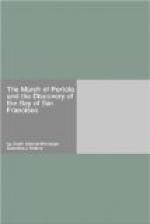a mesa at the foot of a sierra, whence looking across
the sea, they could descry Santa Catalina Island.
This was San Juan Capistrano, and here they rested
on the 25th. On the 28th they reached the Santa
Ana river, near the present town of that name; a violent
shock of earthquake which they experienced caused them
to name the river Jesus de los Temblores[19].
July 30th and 31st they were in the San Gabriel valley,
which they called San Miguel, and on August 1st they
rested near the site of the present city of Los Angeles.
The stop this day, in addition to the needed rest
and the necessity for exploration, was to give opportunity
for the soldiers and people of the expedition to gain
the great indulgence of Porciuncula.[20] The priests
said mass and the sacrament was administered.
In the afternoon the soldiers went to hunt and brought
in an antelope (barrendo), with which the land seemed
to abound. The next day they crossed the Los Angeles
river by the site of the present city, and named it
Rio de Nuestra Senora de Los Angeles de Porciuncula[21].
Passing up the river, they went through the canon
and came into the San Fernando valley, which they
called Valle de Santa Catalina de los Encinos —
Valley of St. Catherine of the Oaks. Five days
they spent in the valley, and crossing the Santa Susana
mountains, perhaps by the Tapo canon, they came to
the Santa Clara river near the site of Camulos, and
there rested, August 9th. Portola named the river
Santa Clara, which name it still bears, in honor of
the saint, whose day, August 12th, was observed by
them. Five days, by easy jornadas, they traveled
down the river, and arrived on the 14th at the first
rancheria[22] of the Channel Indians. It being
the vespers of the feast of La Asuncion de Nuestra
Senora, Portola named the village La Asuncion.
It contained about thirty large, well-constructed houses
of clay and rushes, and each house held three or four
families. These Indians were of good size, well-formed,
active, industrious, and very skillful in constructing
boats, wooden bowls, and other articles. Portola
thought this pueblo must be the one named by Cabrillo,
Pueblo de Canoas (Pueblo of the Boats). This
was the site selected for the mission of San Buenaventura,
founded March 31, 1782. The natives received them
kindly, gave them an abundance of food, and showed
them their well-made boats, twenty-four feet long,
made of pine boards tied together with cords and covered
with asphaltum, and capable of carrying ten men each.
The next four days they followed the beach and camped,
on August 18th, at a large laguna, called by them
La Laguna de la Concepcion. This was the site
of the future presidio and mission of Santa Barbara.
Everywhere were large populous rancherias of the Indians,
and everywhere they were received in the most hospitable
manner and provided with more food than they could
eat. The next stop was three leagues beyond, on
the shore of a large lagoon and marsh, containing
a good-sized island on which was a large rancheria,




